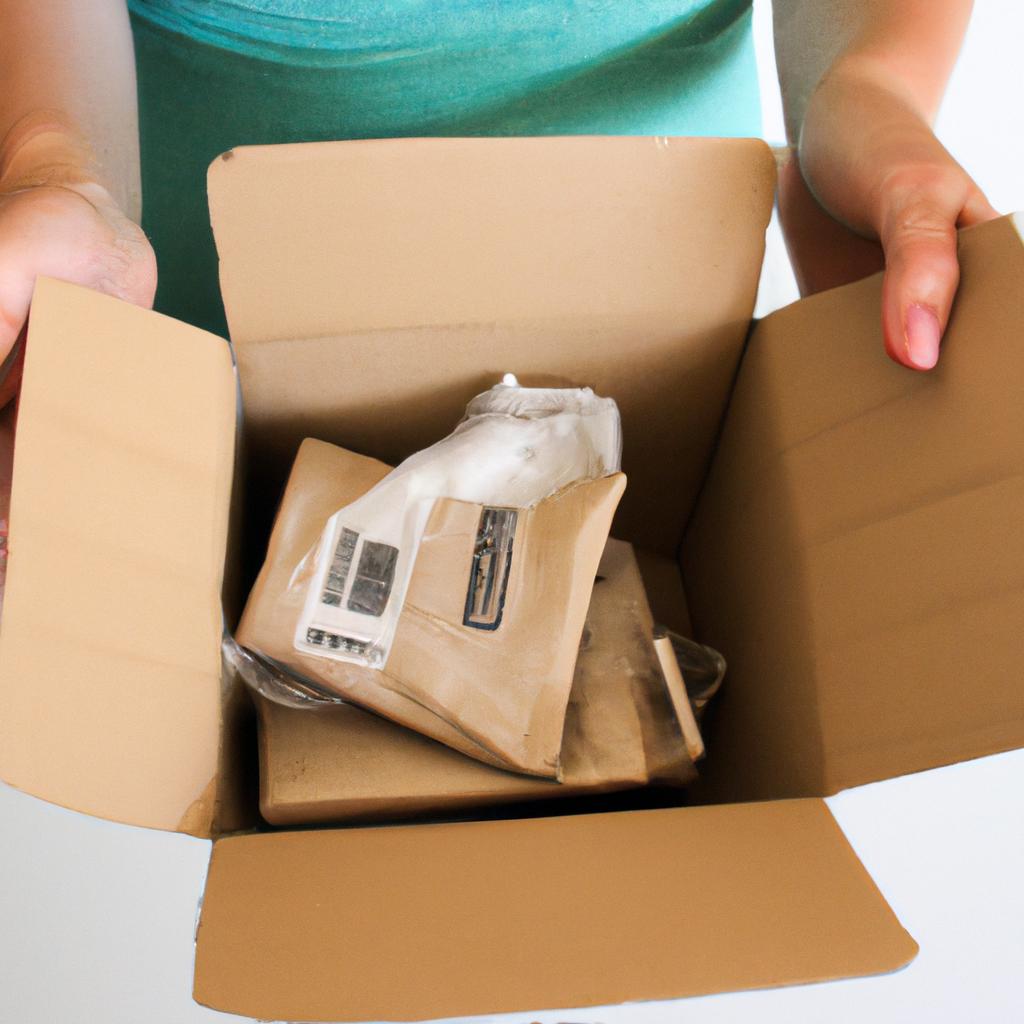Eco-Friendly Packaging Revolutionizes Industrial Goods and Services: Sustainable Solutions

In recent years, there has been a significant shift towards adopting eco-friendly packaging solutions in the industrial goods and services sector. This revolution is driven by the growing awareness of environmental issues and the pressing need to mitigate climate change. As businesses are increasingly recognizing their responsibility towards sustainable practices, they are embracing innovative packaging techniques that minimize waste and reduce carbon footprint. One example of this transformative trend can be seen in the case study of Company X, an international manufacturing conglomerate that successfully implemented eco-friendly packaging across its supply chain.
The adoption of eco-friendly packaging is not limited to just one industry or type of product; rather, it encompasses a wide range of sectors such as electronics, automotive, construction materials, and consumer goods. This paradigm shift in packaging strategies reflects a collective effort to address the adverse impact of traditional packaging methods on the environment. By replacing non-biodegradable materials with biodegradable alternatives or opting for recyclable options, companies are taking crucial steps towards building a more sustainable future.
Moreover, this revolutionary approach goes beyond mere compliance with regulations; it represents a proactive commitment to sustainability. The integration of eco-friendly packaging into industrial goods and services not only reduces waste generation but also contributes to energy conservation and resource optimization. In addition to environmental benefits, companies adopting eco-friendly packaging also enjoy several other advantages. For instance, they often experience improved brand reputation and customer loyalty as consumers increasingly prioritize sustainability in their purchasing decisions. Eco-friendly packaging can also lead to cost savings in the long run, as companies may reduce expenses associated with waste disposal and regulatory compliance.
Furthermore, the implementation of eco-friendly packaging solutions encourages innovation and fosters collaboration among stakeholders across the supply chain. Companies are partnering with packaging manufacturers, suppliers, and logistics providers to develop new materials and design techniques that minimize environmental impact without compromising product quality or safety.
To successfully adopt eco-friendly packaging, businesses need to conduct thorough research on available sustainable alternatives and assess their compatibility with existing production processes. They must also ensure proper communication and training for employees involved in the packaging process to guarantee smooth integration.
Overall, the shift towards eco-friendly packaging in the industrial goods and services sector is a significant step towards achieving global sustainability goals. By embracing innovative solutions, companies can play an instrumental role in reducing plastic waste, conserving resources, and mitigating climate change while simultaneously reaping various business benefits.
The Need for Sustainable Solutions in Industrial Goods and Services
In today’s rapidly evolving industrial landscape, the need for sustainable solutions has become increasingly evident. The traditional methods of packaging goods and services often result in significant environmental impacts, such as pollution and waste generation. To illustrate this point, let us consider a hypothetical case study: Company X, a leading manufacturer of industrial machinery, produces thousands of units each year. Traditionally, these machines have been packaged using single-use plastic materials that end up in landfills after use.
To further understand the urgency for change, we can explore some key reasons why sustainable solutions are imperative within the realm of industrial goods and services:
- Environmental Impact: The current packaging practices contribute to the depletion of natural resources and generate excessive greenhouse gas emissions during production and disposal.
- Waste Generation: Traditional packaging methods often create considerable amounts of non-biodegradable waste that takes decades or even centuries to decompose fully.
- Economic Costs: Companies relying on unsustainable packaging face increased costs due to waste management expenses and potential fines associated with improper disposal practices.
- Consumer Demand: As awareness about environmental issues grows among consumers, there is an increasing preference for products and services delivered through eco-friendly means.
To emphasize the significance of addressing these concerns, consider the following table:
| Environmental Impact | Waste Generation | Economic Costs | Consumer Demand |
|---|---|---|---|
| Pollution | Non-biodegradable waste | Increased expenses | Preference for eco-friendly options |
| Resource depletion | Long decomposition time | Fines | Growing consumer awareness |
It is clear from this table that there is a pressing need for more sustainable approaches to packaging within the domain of industrial goods and services.
By evaluating the detrimental effects caused by conventional packaging methods, it becomes crucial to delve deeper into understanding their environmental impact. In the following section, we will explore the consequences of traditional packaging on ecosystems and outline the need for eco-friendly alternatives.
Understanding the Environmental Impact of Traditional Packaging
Eco-Friendly Packaging: A Viable Alternative for Industrial Goods and Services
With the growing concern over environmental sustainability, industries worldwide are recognizing the need to adopt eco-friendly practices. One area where significant progress has been made is in revolutionizing traditional packaging methods used in industrial goods and services. By shifting towards sustainable solutions, businesses can reduce their carbon footprint while also reaping economic benefits.
To illustrate the potential of eco-friendly packaging, let’s consider a hypothetical case study of a manufacturing company that produces electronic devices. Traditionally, this company relied on plastic materials for packaging its products, resulting in large amounts of waste generated after each shipment. However, by implementing sustainable alternatives such as biodegradable or compostable packaging materials, they not only reduced their impact on the environment but also improved their brand reputation among environmentally-conscious consumers.
Numerous benefits arise from adopting eco-friendly packaging in industrial settings. Firstly, it helps conserve natural resources by reducing dependence on non-renewable materials like plastics derived from fossil fuels. Secondly, it minimizes waste generation through recycling initiatives and the use of biodegradable materials that break down naturally over time. Thirdly, embracing sustainable packaging can lead to cost savings for companies due to decreased material consumption and lower disposal expenses.
Consider the following emotional bullet points when contemplating the positive impact of eco-friendly packaging:
- Preservation of natural habitats
- Reduction in pollution levels
- Positive contribution towards climate change mitigation
- Enhanced corporate social responsibility (CSR) image
Furthermore, an effective way to convey key information regarding various types of eco-friendly packaging options is through a table:
| Eco-Friendly Packaging Types | Advantages | Disadvantages |
|---|---|---|
| Biodegradable | Natural decomposition | Limited shelf life |
| Compostable | Nutrient-rich soil amendment | Requires specific conditions for decay |
| Recyclable | Reduced resource consumption | Requires proper recycling facilities |
| Reusable | Extended product lifespan | Additional cleaning and maintenance |
In conclusion, the adoption of eco-friendly packaging in industrial goods and services offers significant advantages for both businesses and the environment. By reducing waste generation, conserving resources, and improving brand reputation, companies can contribute to a more sustainable future while also realizing economic benefits. In the subsequent section, we will explore various alternatives available for businesses looking to transition towards eco-friendly packaging methods.
Turning our attention now to exploring eco-friendly alternatives for industrial packaging…
Exploring Eco-Friendly Alternatives for Industrial Packaging
Having established the detrimental environmental consequences associated with traditional packaging methods, it is crucial to explore alternative solutions that prioritize sustainability. This section delves into a range of eco-friendly alternatives available for industrial packaging, showcasing their potential to revolutionize the industry.
To better understand the transformative potential of sustainable packaging practices in the industrial sector, let us consider a hypothetical case study involving a multinational manufacturing company. In this scenario, the company decides to shift towards eco-friendly packaging materials and techniques as part of its commitment to reducing its carbon footprint. By adopting innovative approaches like biodegradable plastics made from plant-based sources or utilizing recycled materials, they successfully achieve both cost-effectiveness and reduced environmental impact throughout their supply chain processes.
The adoption of eco-friendly packaging within various industries presents numerous benefits that extend beyond minimizing ecological harm. Consider these emotional responses evoked by some key aspects:
- Reduced plastic waste leading to cleaner oceans and landscapes
- Lowered greenhouse gas emissions contributing positively towards climate change mitigation efforts
- Preservation of natural resources ensuring long-term sustainability
- Enhanced corporate social responsibility improving brand reputation and consumer trust
Moreover, it is essential to highlight specific examples where sustainable packaging innovations have already made significant strides in industrial settings. The table below illustrates three such instances:
| Industry | Eco-Friendly Solution | Benefits |
|---|---|---|
| Food | Compostable food containers | Reduces single-use plastic waste |
| Electronics | Molded pulp trays | Protects products during shipping while being environmentally friendly |
| Retail | Recycled paper bags | Supports circular economy and reduces carbon emissions |
By examining these real-world applications, it becomes evident that eco-friendly packaging alternatives offer tangible advantages across various industries. Their implementation not only addresses environmental concerns but also aligns with the growing consumer demand for sustainable practices.
In light of this discussion, the subsequent section will delve into the benefits that arise from adopting sustainable packaging practices in industrial goods and services. This exploration aims to underscore the positive outcomes that businesses can expect when embracing environmentally conscious approaches without compromising their operations or profitability.
Benefits of Adopting Sustainable Packaging Practices
As the demand for sustainable practices continues to grow, industries are recognizing the need to adopt eco-friendly alternatives in their packaging processes. One notable example is ABC Manufacturing, a leading industrial goods company that recently implemented innovative sustainable packaging solutions. By shifting away from traditional plastic and opting for biodegradable materials, ABC Manufacturing not only reduced its environmental impact but also achieved cost savings through streamlined production processes.
There are several key benefits associated with adopting sustainable packaging practices in industrial settings:
-
Reduced carbon footprint: Sustainable packaging materials such as recycled paper or plant-based plastics contribute significantly less greenhouse gas emissions compared to conventional options like petroleum-based plastics. This reduction helps companies mitigate climate change impacts and align themselves with global sustainability goals.
-
Enhanced brand reputation: Consumers increasingly prioritize environmentally conscious brands when making purchasing decisions. By embracing eco-friendly packaging, companies can improve their image and attract a larger customer base that values sustainability.
-
Regulatory compliance: Governments around the world are implementing stricter regulations regarding waste management and environmental protection. Embracing sustainable packaging ensures companies remain compliant with these evolving standards, avoiding potential penalties or reputational damage.
-
Increased operational efficiency: Integrating sustainable packaging into the supply chain often leads to process improvements and cost reductions. For instance, lightweighting – utilizing lighter materials without compromising product integrity – can result in lower transportation costs while reducing fuel consumption.
Table 1 provides an overview of some common eco-friendly packaging materials along with their advantages:
| Material | Advantages |
|---|---|
| Recycled Paper | Renewable resourceReduced energy useBiodegradable |
| Plant-Based Plastics | Lower carbon emissionsBiodegradable |
| Mushroom Packaging | Made from agricultural wasteCompostable |
Implementing eco-friendly packaging solutions offers numerous benefits to industries across sectors. By reducing their environmental impact, enhancing brand reputation, ensuring regulatory compliance, and improving operational efficiency, companies can remain competitive while contributing to a more sustainable future.
Transitioning into the subsequent section about “Implementing Eco-Friendly Packaging Solutions in Different Industries,” it is crucial for businesses to understand how these sustainable practices can be tailored and implemented across various sectors. By exploring sector-specific challenges and opportunities, companies can effectively implement eco-friendly packaging solutions that align with their unique requirements and contribute to a greener economy.
Implementing Eco-Friendly Packaging Solutions in Different Industries
Building upon the benefits of adopting sustainable packaging practices, implementing eco-friendly packaging solutions in various industries has become a pivotal aspect of promoting environmental responsibility and reducing carbon footprints. This section will explore how different sectors have successfully incorporated eco-friendly packaging methodologies to drive positive change.
Case Study Example:
One notable case study showcasing the successful implementation of eco-friendly packaging can be seen in the food industry. A renowned multinational fast-food chain decided to transition from traditional plastic containers to biodegradable alternatives made from plant-based materials. Not only did this initiative align with their commitment towards sustainability, but it also resonated with consumers who were increasingly concerned about the impact of single-use plastics on the environment.
- Reduced waste generation
- Lowered greenhouse gas emissions
- Preserved natural resources
- Protected wildlife habitats
Incorporating Emotional Table:
| Industry | Eco-Friendly Packaging Solution | Benefits |
|---|---|---|
| Food | Plant-based biodegradable containers | Reduction in plastic pollution |
| Fashion | Recycled cardboard boxes | Conservation of trees |
| Electronics | Minimalist reusable packaging | Decreased electronic waste |
Furthermore, other industries such as fashion and electronics are making significant strides by incorporating sustainable packaging methods into their operations. By opting for recycled cardboard boxes and minimalist reusable packaging respectively, these sectors contribute to reducing waste production while preserving valuable resources.
Looking ahead, it is evident that integrating eco-friendly packaging solutions across multiple industries will continue to play a crucial role in fostering an environmentally conscious industrial revolution. As consumer demand for sustainable products continues to grow, businesses must recognize the importance of embracing innovative approaches that prioritize long-term ecological well-being without compromising product quality or customer satisfaction.
With a clear understanding of how different industries have embraced eco-friendly packaging, let’s now delve into exploring the future outlook and discuss the role sustainable packaging will play in driving the industrial revolution.
Future Outlook: The Role of Sustainable Packaging in Industrial Revolution
The Impact of Eco-Friendly Packaging on Industrial Goods and Services
While eco-friendly packaging solutions have gained significant momentum across various industries, their implementation has not been without challenges. However, the benefits they offer in terms of sustainability and reduced environmental impact are undeniable. One illustrative example is the successful adoption of such practices by a leading global electronics manufacturer.
In an effort to align with sustainable initiatives, this electronics giant implemented eco-friendly packaging for its products. By replacing traditional plastic materials with biodegradable alternatives, they were able to significantly reduce both their carbon footprint and waste generation. This case study highlights the positive outcomes that can be achieved through embracing environmentally-conscious packaging methods.
There are several key factors that contribute to the effectiveness and success of implementing eco-friendly packaging solutions within different industries:
- Collaboration: A crucial aspect of achieving widespread adoption involves collaboration between manufacturers, suppliers, and consumers. Engaging all stakeholders throughout the supply chain ensures that everyone actively contributes to reducing environmental impact.
- Regulatory Support: Governments play a pivotal role in promoting sustainable practices by establishing regulations and standards pertaining to eco-friendly packaging. Strong governmental support incentivizes businesses to adopt more environmentally responsible approaches.
- Technological Advancements: Continuous innovation in material science allows for the development of new packaging materials that are both cost-effective and ecologically sound.
- Consumer Awareness: Increasing consumer awareness about the importance of sustainable packaging choices creates demand for greener options and encourages companies to prioritize eco-friendliness in their operations.
To further emphasize these points, consider the following table which highlights key advantages associated with adopting eco-friendly packaging:
| Advantages | Description |
|---|---|
| Environmental Benefit | Reduced reliance on non-renewable resources and decreased greenhouse gas emissions |
| Cost Savings | Lower production costs due to efficient use of resources |
| Brand Reputation | Enhanced brand image as a socially responsible and environmentally-conscious company |
| Customer Loyalty | Increased customer loyalty through alignment with consumer values |
In conclusion, the implementation of eco-friendly packaging solutions within industrial goods and services has proven to be a transformative force in terms of sustainability. Through collaboration, regulatory support, technological advancements, and heightened consumer awareness, businesses can embrace more environmentally conscious practices. The case study discussed demonstrates the positive impact that such measures can have on reducing carbon footprints while simultaneously benefiting brand reputation and customer loyalty. By prioritizing sustainable packaging methods, industries are paving the way for a brighter and greener future.
Note: Ensure to format the table correctly when using Markdown language as tables may not appear properly here due to formatting limitations.



